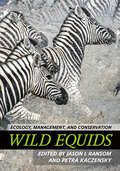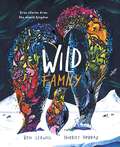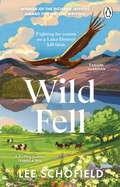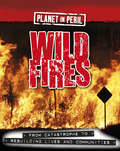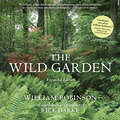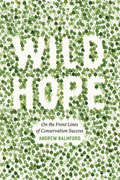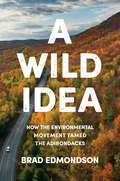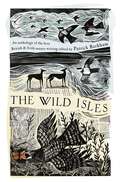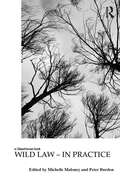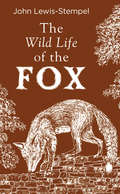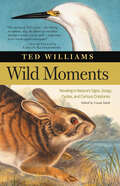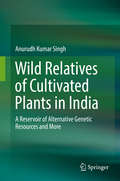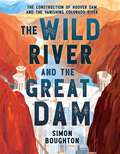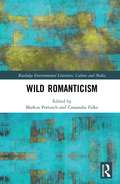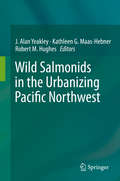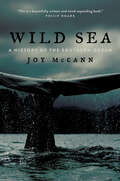- Table View
- List View
Wild Equids: Ecology, Management, and Conservation
by Jason I. Ransom Petra KaczenskyWild horses, zebras, asses, and feral equines exhibit intriguing and complex social structures that captivate the human imagination and elicit a wide range of emotions that influence conservation and management efforts. This book, spearheaded by Jason I. Ransom and Petra Kaczensky, brings together the world's leading experts on equid ecology, management, and conservation to provide a synthesis of what is known about these iconic species and what needs to be done to prevent losing some of them altogether. The most comprehensive conservation book on wild equids in decades, this title will enlighten not only equid researchers, but also mammalogists, conservationists, and equine professionals. Readers will find new insight into the lives of the world's horses, zebras, and asses, understand the basis of our relationships with these animals, and develop a greater understanding of where equids come from and why they are worth conserving.Included in this book are detailed, state-of-the-science syntheses on Social structure, behavior, and cognition Habitat and diet Ecological niches Population dynamics Roles of humans in horse distribution through time Human dimensions and the meaning of wild Management of free-roaming horses Captive breeding of wild equids Conservation of wild equids Conservation of migrations Reintroductions Genetics and paleogenetics
Wild Family
by Ben LerwillFamilies come in all shapes and sizes, from spiders who can carry hundreds of their babies, to elephants who babysit each other's calves. Perfect for every animal and wildlife fan, discover the incredible true stories of our wilder family members . . .Did you know that clownfish can have hundreds of babies?Or that some families like to be on the move, like monarch butterflies who will travel together for their entire lives!Did you know that lions are ruled by a king, but in a bee family the queen is the boss . . .Meet families of all shapes and sizes, in these incredible true stories about wild families. These fascinating stories for curious young minds are fully illustrated with imaginative, colourful artwork, perfect for dipping into and to treasure all year round.
Wild Fell: Fighting for nature on a Lake District hill farm
by Lee Schofield'I found myself turning the pages with an inward leap of joy' - Isabella TreeIn 2015, England's last and loneliest golden eagle died in an unmarked spot among the remote eastern fells of the Lake District. It was a tragic day for the nation's wildlife, but the fight to restore the landscape had already begun.Lee Schofield, ecologist and site manager for RSPB Haweswater is leading efforts to breathe life back into two hill farms and their thirty square kilometres of sprawling upland habitat. The farms sit at the edge of the region's largest reservoir, beneath which lie the remains of a submerged village. The area's history has been a turbulent one for both its people and its wildlife, leaving its habitats in tatters.In the search for inspiration, Lee sought out England's rarest mountain flower and travelled from the wild fells of Norway to the pristine meadows of the Alps. Informed, too, by the local land, its history and the people who have shaped it, Lee and his team have remeandered a straightened river and are repairing damaged wetlands, meadows and woods. Each year, the landscape is becoming richer, wilder and better able to withstand the shocks of a changing climate. But in the contested landscape of the Lake District, change is not always welcomed, and success relies on finding a balance between rewilding and respecting cherished farming traditions. This is not only a story of nature in recovery, it is also the story of Lee's personal connection to place, and the highs and lows of working for nature amid fierce opposition.Wild Fell is a call to recognise that the solutions for a richer world lie at our feet; by focusing on flowers, we can rebuild landscapes fit for eagles again. A landscape of flowers is a landscape of hope.
Wild Fires (Planet in Peril #1)
by Cath SenkerExtreme weather dominates news bulletins around the world. From tsunamis to superstorms, floods to wild fires, natural disasters affect people globally on a daily basis. Wild fires, and their deadly consequences, have hit the headlines over the past decade as huge fires have devastated areas in countries around the world. But why are these occurrences becoming more frequent, and more severe? And what happens to the affected communities after disaster has struck? Planet in Peril: Wild Fires answers these questions and many more, including when and why wild fires occur, and how technology is helping people to prepare for, and protect themselves against, them. The book looks at three of these natural disasters from recent years in detail: the Black Saturday bushfires in Australia in 2009, the Colorado wildfire of 2012 and the forest fires in Bolivia in 2010. Comprehensive case studies cover when and where the fires started, the immediate impact of the disaster, the fire damage, the long-term effects, the global aid efforts and the rebuilding and regeneration of affected communities. Eyewitness panels give firsthand accounts of the disaster from flood victims, emergency service personnel, including the rural fire service involved, aid workers and scientists working to combat the effects of natural disasters. Infographic elements display statistics about each wild fire in a clear, concise and visual way. Learn about the preparations made for wild fires: what protective mechanisms and warning systems are in place, the emergency drills people must learn, and how communities are evacuated in the event of a disaster. Find out about the disaster recovery effort immediately after each event, how aid reaches affected areas, and where it comes from. See how communities fare in the immediate aftermath, how they cope with damage to infrastructure and homes, lack of basic necessities and, in some cases, the loss of friends or relatives. Then find out how they cope long-term, deal with the economic impact, and regenerate. Discover whether climate change and global warming are increasing the impact and severity of wild fires, and how research is being done, and technology developed, to combat it. See how warning systems and evacuation drills can dramatically improve people's chances of survival, and learn about some solutions, such as firebreaks, that reduce the impact of wild fires. Planet in Peril: Wild Fires is ideal for children age 9+, for geography and science projects, or simply for anyone interested in finding out the background behind the 'extreme weather' news reports. Wild fires are not the only natural disaster our planet faces, find out about tsunamis, superstorms and floods in other titles in the series.
The Wild Garden: Expanded Edition
by William RobinsonA rich combination of original text, modern commentary, and lush photography makes this new edition essential reading for anyone who wants to understand how we have arrived at our present assumptions about gardening and where we still need to go.
Wild Hope: On the Front Lines of Conservation Success
by Andrew BalmfordTropical deforestation. The collapse of fisheries. Unprecedented levels of species extinction. Faced with the plethora of gloom-and-doom headlines about the natural world, we might think that environmental disaster is inevitable. But is there any good news about the environment? Yes, there is, answers Andrew Balmford in Wild Hope, and he offers several powerful stories of successful conservation to prove it. This tragedy is still avoidable, and there are many reasons for hope if we find inspiration in stories of effective environmental recovery. Wild Hope is organized geographically, with each chapter taking readers to extraordinary places to meet conservation’s heroes and foot soldiers—and to discover the new ideas they are generating about how to make conservation work on our hungry and crowded planet. The journey starts in the floodplains of Assam, where dedicated rangers and exceptionally tolerant villagers have together helped bring Indian rhinos back from the brink of extinction. In the pine forests of the Carolinas, we learn why plantation owners came to resent rare woodpeckers—and what persuaded them to change their minds. In South Africa, Balmford investigates how invading alien plants have been drinking the country dry, and how the Southern Hemisphere’s biggest conservation program is now simultaneously restoring the rivers, saving species, and creating tens of thousands of jobs. The conservation problems Balmford encounters are as diverse as the people and their actions, but together they offer common themes and specific lessons on how to win the battle of conservation—and the one essential ingredient, Balmford shows, is most definitely hope. Wild Hope, though optimistic, is a clear-eyed view of the difficulties and challenges of conservation. Balmford is fully aware of failed conservation efforts and systematic flaws that make conservation difficult, but he offers here innovative solutions and powerful stories of citizens, governments, and corporations coming together to implement them. A global tour of people and programs working for the planet, Wild Hope is an emboldening green journey.
Wild Hope: On the Front Lines of Conservation Success
by Andrew BalmfordTropical deforestation. The collapse of fisheries. Unprecedented levels of species extinction. Faced with the plethora of gloom-and-doom headlines about the natural world, we might think that environmental disaster is inevitable. But is there any good news about the environment? Yes, there is, answers Andrew Balmford in Wild Hope, and he offers several powerful stories of successful conservation to prove it. This tragedy is still avoidable, and there are many reasons for hope if we find inspiration in stories of effective environmental recovery. Wild Hope is organized geographically, with each chapter taking readers to extraordinary places to meet conservation’s heroes and foot soldiers—and to discover the new ideas they are generating about how to make conservation work on our hungry and crowded planet. The journey starts in the floodplains of Assam, where dedicated rangers and exceptionally tolerant villagers have together helped bring Indian rhinos back from the brink of extinction. In the pine forests of the Carolinas, we learn why plantation owners came to resent rare woodpeckers—and what persuaded them to change their minds. In South Africa, Balmford investigates how invading alien plants have been drinking the country dry, and how the Southern Hemisphere’s biggest conservation program is now simultaneously restoring the rivers, saving species, and creating tens of thousands of jobs. The conservation problems Balmford encounters are as diverse as the people and their actions, but together they offer common themes and specific lessons on how to win the battle of conservation—and the one essential ingredient, Balmford shows, is most definitely hope. Wild Hope, though optimistic, is a clear-eyed view of the difficulties and challenges of conservation. Balmford is fully aware of failed conservation efforts and systematic flaws that make conservation difficult, but he offers here innovative solutions and powerful stories of citizens, governments, and corporations coming together to implement them. A global tour of people and programs working for the planet, Wild Hope is an emboldening green journey.
Wild Hope: On the Front Lines of Conservation Success
by Andrew BalmfordTropical deforestation. The collapse of fisheries. Unprecedented levels of species extinction. Faced with the plethora of gloom-and-doom headlines about the natural world, we might think that environmental disaster is inevitable. But is there any good news about the environment? Yes, there is, answers Andrew Balmford in Wild Hope, and he offers several powerful stories of successful conservation to prove it. This tragedy is still avoidable, and there are many reasons for hope if we find inspiration in stories of effective environmental recovery. Wild Hope is organized geographically, with each chapter taking readers to extraordinary places to meet conservation’s heroes and foot soldiers—and to discover the new ideas they are generating about how to make conservation work on our hungry and crowded planet. The journey starts in the floodplains of Assam, where dedicated rangers and exceptionally tolerant villagers have together helped bring Indian rhinos back from the brink of extinction. In the pine forests of the Carolinas, we learn why plantation owners came to resent rare woodpeckers—and what persuaded them to change their minds. In South Africa, Balmford investigates how invading alien plants have been drinking the country dry, and how the Southern Hemisphere’s biggest conservation program is now simultaneously restoring the rivers, saving species, and creating tens of thousands of jobs. The conservation problems Balmford encounters are as diverse as the people and their actions, but together they offer common themes and specific lessons on how to win the battle of conservation—and the one essential ingredient, Balmford shows, is most definitely hope. Wild Hope, though optimistic, is a clear-eyed view of the difficulties and challenges of conservation. Balmford is fully aware of failed conservation efforts and systematic flaws that make conservation difficult, but he offers here innovative solutions and powerful stories of citizens, governments, and corporations coming together to implement them. A global tour of people and programs working for the planet, Wild Hope is an emboldening green journey.
Wild Hope: On the Front Lines of Conservation Success
by Andrew BalmfordTropical deforestation. The collapse of fisheries. Unprecedented levels of species extinction. Faced with the plethora of gloom-and-doom headlines about the natural world, we might think that environmental disaster is inevitable. But is there any good news about the environment? Yes, there is, answers Andrew Balmford in Wild Hope, and he offers several powerful stories of successful conservation to prove it. This tragedy is still avoidable, and there are many reasons for hope if we find inspiration in stories of effective environmental recovery. Wild Hope is organized geographically, with each chapter taking readers to extraordinary places to meet conservation’s heroes and foot soldiers—and to discover the new ideas they are generating about how to make conservation work on our hungry and crowded planet. The journey starts in the floodplains of Assam, where dedicated rangers and exceptionally tolerant villagers have together helped bring Indian rhinos back from the brink of extinction. In the pine forests of the Carolinas, we learn why plantation owners came to resent rare woodpeckers—and what persuaded them to change their minds. In South Africa, Balmford investigates how invading alien plants have been drinking the country dry, and how the Southern Hemisphere’s biggest conservation program is now simultaneously restoring the rivers, saving species, and creating tens of thousands of jobs. The conservation problems Balmford encounters are as diverse as the people and their actions, but together they offer common themes and specific lessons on how to win the battle of conservation—and the one essential ingredient, Balmford shows, is most definitely hope. Wild Hope, though optimistic, is a clear-eyed view of the difficulties and challenges of conservation. Balmford is fully aware of failed conservation efforts and systematic flaws that make conservation difficult, but he offers here innovative solutions and powerful stories of citizens, governments, and corporations coming together to implement them. A global tour of people and programs working for the planet, Wild Hope is an emboldening green journey.
Wild Hope: On the Front Lines of Conservation Success
by Andrew BalmfordTropical deforestation. The collapse of fisheries. Unprecedented levels of species extinction. Faced with the plethora of gloom-and-doom headlines about the natural world, we might think that environmental disaster is inevitable. But is there any good news about the environment? Yes, there is, answers Andrew Balmford in Wild Hope, and he offers several powerful stories of successful conservation to prove it. This tragedy is still avoidable, and there are many reasons for hope if we find inspiration in stories of effective environmental recovery. Wild Hope is organized geographically, with each chapter taking readers to extraordinary places to meet conservation’s heroes and foot soldiers—and to discover the new ideas they are generating about how to make conservation work on our hungry and crowded planet. The journey starts in the floodplains of Assam, where dedicated rangers and exceptionally tolerant villagers have together helped bring Indian rhinos back from the brink of extinction. In the pine forests of the Carolinas, we learn why plantation owners came to resent rare woodpeckers—and what persuaded them to change their minds. In South Africa, Balmford investigates how invading alien plants have been drinking the country dry, and how the Southern Hemisphere’s biggest conservation program is now simultaneously restoring the rivers, saving species, and creating tens of thousands of jobs. The conservation problems Balmford encounters are as diverse as the people and their actions, but together they offer common themes and specific lessons on how to win the battle of conservation—and the one essential ingredient, Balmford shows, is most definitely hope. Wild Hope, though optimistic, is a clear-eyed view of the difficulties and challenges of conservation. Balmford is fully aware of failed conservation efforts and systematic flaws that make conservation difficult, but he offers here innovative solutions and powerful stories of citizens, governments, and corporations coming together to implement them. A global tour of people and programs working for the planet, Wild Hope is an emboldening green journey.
Wild Hope: On the Front Lines of Conservation Success
by Andrew BalmfordTropical deforestation. The collapse of fisheries. Unprecedented levels of species extinction. Faced with the plethora of gloom-and-doom headlines about the natural world, we might think that environmental disaster is inevitable. But is there any good news about the environment? Yes, there is, answers Andrew Balmford in Wild Hope, and he offers several powerful stories of successful conservation to prove it. This tragedy is still avoidable, and there are many reasons for hope if we find inspiration in stories of effective environmental recovery. Wild Hope is organized geographically, with each chapter taking readers to extraordinary places to meet conservation’s heroes and foot soldiers—and to discover the new ideas they are generating about how to make conservation work on our hungry and crowded planet. The journey starts in the floodplains of Assam, where dedicated rangers and exceptionally tolerant villagers have together helped bring Indian rhinos back from the brink of extinction. In the pine forests of the Carolinas, we learn why plantation owners came to resent rare woodpeckers—and what persuaded them to change their minds. In South Africa, Balmford investigates how invading alien plants have been drinking the country dry, and how the Southern Hemisphere’s biggest conservation program is now simultaneously restoring the rivers, saving species, and creating tens of thousands of jobs. The conservation problems Balmford encounters are as diverse as the people and their actions, but together they offer common themes and specific lessons on how to win the battle of conservation—and the one essential ingredient, Balmford shows, is most definitely hope. Wild Hope, though optimistic, is a clear-eyed view of the difficulties and challenges of conservation. Balmford is fully aware of failed conservation efforts and systematic flaws that make conservation difficult, but he offers here innovative solutions and powerful stories of citizens, governments, and corporations coming together to implement them. A global tour of people and programs working for the planet, Wild Hope is an emboldening green journey.
A Wild Idea: How the Environmental Movement Tamed the Adirondacks
by Brad EdmondsonA Wild Idea shares the complete story of the difficult birth of the Adirondack Park Agency (APA). The Adirondack region of New York's rural North Country forms the nation's largest State Park, with a territory as large as Vermont. Planning experts view the APA as a triumph of sustainability that balances human activity with the preservation of wild ecosystems. The truth isn't as pretty. The story of the APA, told here for the first time, is a complex, troubled tale of political dueling and communities pushed to the brink of violence. The North Country's environmental movement started among a small group of hunters and hikers, rose on a huge wave of public concern about pollution that crested in the early 1970s, and overcame multiple obstacles to "save" the Adirondacks. Edmondson shows how the movement's leaders persuaded a powerful Governor to recruit planners, naturalists, and advisors and assign a task that had never been attempted before. The team and the politicians who supported them worked around the clock to draft two visionary land-use plans and turn them into law. But they also made mistakes, and their strict regulations were met with determined opposition from local landowners who insisted that private property is private.A Wild Idea is based on in-depth interviews with five dozen insiders who are central to the story. Their observations contain many surprising and shocking revelations. This is a rich, exciting narrative about state power and how it was imposed on rural residents. It shows how the Adirondacks were "saved," and also why that campaign sparked a passionate rebellion.
The Wild Isles: An Anthology of the Best of British and Irish Nature Writing
by Patrick BarkhamThe very best of British and Irish nature writing selected by the natural history writer Patrick Barkham.The landscapes of Britain and Ireland, together with the creatures and plants that inhabit them, have penetrated deep in our collective imagination. From Gilbert White and Dorothy Wordsworth to Laurie Lee and Nan Shepherd, literature inspired by the natural world has become an integral part of our shared identity, and shaped our relationship with the islands we call home.In The Wild Isles, Patrick Barkham has gathered together a wide array of the very best of British and Irish nature writing, characterized by an arresting diversity of moods and voices. His choices are arranged under themes that range from birds, woods and coastlines to childhood, the seasons and urban nature, and juxtapose extracts from much-loved classics with passages by contemporary writers such as Robert Macfarlane, James Rebanks and Helen Macdonald. Here the reader will find joyful celebrations of landscape and the wildlife it nurtures, probing explorations of the environmental problems facing us today, as well as the fresh and vital perspectives of writers from underrepresented backgrounds. 'If British and Irish nature writing is to grow and endure,' writes Barkham in his introduction, 'it must be diverse, complex, multi-faceted and dynamic, and relevant to everyone who lives on this land.'Encompassing the bleak heights of the Cairngorms, the ancient woodlands of Essex, the storm-lashed islands of Ireland's west coast and the lush fields of Devon, The Wild Isles highlights nature's capacity to terrify and to delight, to soothe and to heal, to surprise, inspire and bring wonder.
Wild Law - In Practice (Law, Justice and Ecology)
by Peter Burdon Michelle MaloneyWild Law - In Practice aims to facilitate the transition of Earth Jurisprudence from theory into practice. Earth Jurisprudence is an emerging philosophy of law, coined by cultural historian and geologian Thomas Berry. It seeks to analyse the contribution of law in constructing, maintaining and perpetuating anthropocentrism and addresses the ways in which this orientation can be undermined and ultimately eliminated. In place of anthropocentrism, Earth Jurisprudence advocates an interpretation of law based on the ecocentric concept of an Earth community that includes both human and nonhuman entities. Addressing topics that include a critique of the effectiveness of environmental law in protecting the environment, developments in domestic/constitutional law recognising the rights of nature, and the regulation of sustainability, Wild Law - In Practice is the first book to focus specifically on the practical legal implications of Earth Jurisprudence.
Wild Law - In Practice (Law, Justice and Ecology #4)
by Michelle Maloney Peter BurdonWild Law - In Practice aims to facilitate the transition of Earth Jurisprudence from theory into practice. Earth Jurisprudence is an emerging philosophy of law, coined by cultural historian and geologian Thomas Berry. It seeks to analyse the contribution of law in constructing, maintaining and perpetuating anthropocentrism and addresses the ways in which this orientation can be undermined and ultimately eliminated. In place of anthropocentrism, Earth Jurisprudence advocates an interpretation of law based on the ecocentric concept of an Earth community that includes both human and nonhuman entities. Addressing topics that include a critique of the effectiveness of environmental law in protecting the environment, developments in domestic/constitutional law recognising the rights of nature, and the regulation of sustainability, Wild Law - In Practice is the first book to focus specifically on the practical legal implications of Earth Jurisprudence.
The Wild Life of the Fox
by John Lewis-Stempel"I adore the fox for its magnificence; I hate the fox for killing my chickens. To love and loathe the fox is a British condition."The fox is our apex predator, our most beautiful and clever killer. We have witnessed its wild touch, watched it slink by bins at night and been chilled by its high-pitched scream. And yet we long to stroke the tumbling cubs outside their tunnel homes and watch the vixen stalk the cornfield. There is something about foxes. They captivate us like no other species.Exploring a long and sometimes complicated relationship, The Wild Life of the Fox captures our love – and sometimes loathing – of this magnificent creature in vivid detail and lyrical prose.
Wild Moments
by Ted WilliamsFor more than 30 years Ted Williams has been hailed as one of the foremost nature writers in the United States, with articles and columns that appear in a wide range of national magazines--from Fly Rod & Reel to Audubon. His eloquent advocacy for a host of environmental and wildlife conservation issues have won him prestigious awards. The National Wildlife Federation presented him with their Conservation Achievement Award; his conservation writing won him the Federal Wildlife Officers Association Award; the Outdoor Writers Association of America recognized him with their highest honor, the Jade of Chiefs; and the Coastal Conservation Association of New York named him "Conservationist of the Year."Wild Moments is a collection of Williams's beautifully crafted seasonal observation columns that is sure to be prized by Ted Williams's fans and to attract a broad new readership. The text is complemented by the illustrations of John Burgoyne, himself the winner of more than 150 awards in the United States and Europe.Williams explains the weather conditions that bring out the brightest reds in autumn leaves, when to watch for the massive migration of northern flickers, how hungry wolf spiders catch their prey, and why American goldfinches wait until July or August to build a nest and start breeding.Although Williams's home is in Massachusetts, his columns describe the action of the natural world all across North America, with a few forays to other parts of the globe. So readers will learn why there are so many aspens in Yellowstone National Park and the extent of the burrowing owl's habitat (from southwestern Canada to Argentina).Written in an inviting, accessible, and entertaining style, these brief columns are packed with in-depth information on a broad range of topics. Anyone who loves the natural world will find this book irresistible.
Wild Relatives of Cultivated Plants in India: A Reservoir of Alternative Genetic Resources and More
by Anurudh Kumar SinghThis book provides a comprehensive overview of the wild relatives of crops and cultivated species found in India, covering their distribution, phylogenetic relationships with cultivated species, traits that are of economic and breeding value, and the perceived threats. It highlights the opportunities the wild relatives of cultivated species offer in terms of new genes and allelic variability, as well as several other exploitable economic and environmental benefits that can be harnessed with their conservation and cultivation. This helps facilitate their use – both directly and as part of the breeding program for related cultivated species, filling the gaps of genetic variability in the primary gene pool. It also discusses how they can be used in breeding programs using conventional technologies and the biotechnological approaches of recombinant DNA. Transfer of natural genes using recombinant DNA, known as “Cisgenesis,” can accelerate the process of incorporating these natural genes without genetic drag of undesirable features and biosafety concerns, and beyond taxonomic boundaries, in response to the demand for new cultivars to meet the challenges of climate change and ever-growing human population.
The Wild River and the Great Dam: The Construction of Hoover Dam and the Vanishing Colorado River
by Simon Boughton★ "In this detailed and informative work, Boughton chronicles the construction of the Hoover Dam via compellingly comprehensive text." —Publishers Weekly, starred review ★ "This well-written narrative is bound to become the authority on this modern American marvel." —Booklist, starred review"A fascinating blend of social and environmental history and engineering." —Kirkus Reviews "Truly breathtaking. This is a powerful story and like the water slowly rising behind that concrete barrier, it becomes more powerful with each page turn." —David Macaulay, two-time recipient of the Caldecott Medal and creator of the bestselling The Way Things Work"An exciting mix of research, storytelling, and an astounding true story—one that&’s still unfolding today." —Steve Sheinkin, three-time National Book Award finalist and Newbery Honor author of Bomb Discover the complicated history behind the construction of Hoover Dam—one of the country&’s most recognizable and far-reaching landmarks—and its lasting political and environmental effects on the Colorado River and the American West. At the time of its completion in 1936, Hoover Dam was the biggest dam in the world and the largest feat of architecture and engineering in the country—a statement of national ambition and technical achievement. It turned the wild Colorado River into a tame and securely managed water source, transforming millions of acres of desert into farmland while also providing water and power to the fast-growing population of the Southwest. The concrete monolith quickly became a symbol of American ingenuity; however, its history is laden with contradiction. It provided work for thousands, but it was a dangerous project that exploited desperate workers during the Depression. It helped secure the settlement and economies of the Southwest, but at the expense of Indigenous peoples and the environment; and it created a dependency on the Colorado River&’s water, which is under threat from overuse and climate change. Weaving together elements of engineering, geography, and political and socioeconomic history, and drawing heavily from unpublished oral histories taken from dam workers and their families, Simon Boughton&’s thoughtful and compelling debut—featuring historical photographs throughout—follows the construction and impact of Hoover Dam, and how its promise of abundance ultimately created a river in crisis today.
Wild Romanticism (Routledge Environmental Literature, Culture and Media)
by Markus Poetzsch Cassandra FalkeWild Romanticism consolidates contemporary thinking about conceptions of the wild in British and European Romanticism, clarifying the emergence of wilderness as a cultural, symbolic, and ecological idea. This volume brings together the work of twelve scholars, who examine representations of wildness in canonical texts such as Frankenstein, Northanger Abbey, "Kubla Khan," "Expostulation and Reply," and Childe Harold´s Pilgrimage, as well as lesser-known works by Radcliffe, Clare, Hölderlin, P.B. Shelley, and Hogg. Celebrating the wild provided Romantic-period authors with a way of thinking about nature that resists instrumentalization and anthropocentricism, but writing about wilderness also engaged them in debates about the sublime and picturesque as aesthetic categories, about gender and the cultivation of independence as natural, and about the ability of natural forces to resist categorical or literal enclosure. This book will be of great interest to students and scholars of Romanticism, environmental literature, environmental history, and the environmental humanities more broadly.
Wild Romanticism (Routledge Environmental Literature, Culture and Media)
by Markus Poetzsch Cassandra FalkeWild Romanticism consolidates contemporary thinking about conceptions of the wild in British and European Romanticism, clarifying the emergence of wilderness as a cultural, symbolic, and ecological idea. This volume brings together the work of twelve scholars, who examine representations of wildness in canonical texts such as Frankenstein, Northanger Abbey, "Kubla Khan," "Expostulation and Reply," and Childe Harold´s Pilgrimage, as well as lesser-known works by Radcliffe, Clare, Hölderlin, P.B. Shelley, and Hogg. Celebrating the wild provided Romantic-period authors with a way of thinking about nature that resists instrumentalization and anthropocentricism, but writing about wilderness also engaged them in debates about the sublime and picturesque as aesthetic categories, about gender and the cultivation of independence as natural, and about the ability of natural forces to resist categorical or literal enclosure. This book will be of great interest to students and scholars of Romanticism, environmental literature, environmental history, and the environmental humanities more broadly.
Wild Salmonids in the Urbanizing Pacific Northwest
by J. Alan Yeakley Kathleen G. Maas-Hebner Robert M. HughesWild salmon, trout, char, grayling, and whitefish (collectively salmonids) have been a significant local food and cultural resource for Pacific Northwest peoples for millennia. The location, size, and distribution of urban areas along streams, rivers, estuaries, and coasts directly and indirectly alter and degrade wild salmonid populations and their habitats. Although urban and exurban areas typically cover a smaller fraction of the landscape than other land uses combined, they have profound consequences for local ecosystems, aquatic and terrestrial populations, and water quality and quantity.
Wild Sea: A History of the Southern Ocean
by Joy McCann“The Southern Ocean is a wild and elusive place, an ocean like no other. With its waters lying between the Antarctic continent and the southern coastlines of Australia, New Zealand, South America, and South Africa, it is the most remote and inaccessible part of the planetary ocean, the only part that flows around Earth unimpeded by any landmass. It is notorious amongst sailors for its tempestuous winds and hazardous fog and ice. Yet it is a difficult ocean to pin down. Its southern boundary, defined by the icy continent of Antarctica, is constantly moving in a seasonal dance of freeze and thaw. To the north, its waters meet and mingle with those of the Atlantic, Indian, and Pacific Oceans along a fluid boundary that defies the neat lines of a cartographer.” So begins Joy McCann’s Wild Sea, the remarkable story of the world’s remote Southern, or Antarctic, Ocean. Unlike the Pacific, Atlantic, Indian, and Arctic Oceans with their long maritime histories, little is known about the Southern Ocean. This book takes readers beyond the familiar heroic narratives of polar exploration to explore the nature of this stormy circumpolar ocean and its place in Western and Indigenous histories. Drawing from a vast archive of charts and maps, sea captains’ journals, whalers’ log books, missionaries’ correspondence, voyagers’ letters, scientific reports, stories, myths, and her own experiences, McCann embarks on a voyage of discovery across its surfaces and into its depths, revealing its distinctive physical and biological processes as well as the people, species, events, and ideas that have shaped our perceptions of it. The result is both a global story of changing scientific knowledge about oceans and their vulnerability to human actions and a local one, showing how the Southern Ocean has defined and sustained southern environments and people over time. Beautifully and powerfully written, Wild Sea will raise a broader awareness and appreciation of the natural and cultural history of this little-known ocean and its emerging importance as a barometer of planetary climate change.
Wild Sea: A History of the Southern Ocean
by Joy McCann“The Southern Ocean is a wild and elusive place, an ocean like no other. With its waters lying between the Antarctic continent and the southern coastlines of Australia, New Zealand, South America, and South Africa, it is the most remote and inaccessible part of the planetary ocean, the only part that flows around Earth unimpeded by any landmass. It is notorious amongst sailors for its tempestuous winds and hazardous fog and ice. Yet it is a difficult ocean to pin down. Its southern boundary, defined by the icy continent of Antarctica, is constantly moving in a seasonal dance of freeze and thaw. To the north, its waters meet and mingle with those of the Atlantic, Indian, and Pacific Oceans along a fluid boundary that defies the neat lines of a cartographer.” So begins Joy McCann’s Wild Sea, the remarkable story of the world’s remote Southern, or Antarctic, Ocean. Unlike the Pacific, Atlantic, Indian, and Arctic Oceans with their long maritime histories, little is known about the Southern Ocean. This book takes readers beyond the familiar heroic narratives of polar exploration to explore the nature of this stormy circumpolar ocean and its place in Western and Indigenous histories. Drawing from a vast archive of charts and maps, sea captains’ journals, whalers’ log books, missionaries’ correspondence, voyagers’ letters, scientific reports, stories, myths, and her own experiences, McCann embarks on a voyage of discovery across its surfaces and into its depths, revealing its distinctive physical and biological processes as well as the people, species, events, and ideas that have shaped our perceptions of it. The result is both a global story of changing scientific knowledge about oceans and their vulnerability to human actions and a local one, showing how the Southern Ocean has defined and sustained southern environments and people over time. Beautifully and powerfully written, Wild Sea will raise a broader awareness and appreciation of the natural and cultural history of this little-known ocean and its emerging importance as a barometer of planetary climate change.
Wild Sea: A History of the Southern Ocean
by Joy McCann“The Southern Ocean is a wild and elusive place, an ocean like no other. With its waters lying between the Antarctic continent and the southern coastlines of Australia, New Zealand, South America, and South Africa, it is the most remote and inaccessible part of the planetary ocean, the only part that flows around Earth unimpeded by any landmass. It is notorious amongst sailors for its tempestuous winds and hazardous fog and ice. Yet it is a difficult ocean to pin down. Its southern boundary, defined by the icy continent of Antarctica, is constantly moving in a seasonal dance of freeze and thaw. To the north, its waters meet and mingle with those of the Atlantic, Indian, and Pacific Oceans along a fluid boundary that defies the neat lines of a cartographer.” So begins Joy McCann’s Wild Sea, the remarkable story of the world’s remote Southern, or Antarctic, Ocean. Unlike the Pacific, Atlantic, Indian, and Arctic Oceans with their long maritime histories, little is known about the Southern Ocean. This book takes readers beyond the familiar heroic narratives of polar exploration to explore the nature of this stormy circumpolar ocean and its place in Western and Indigenous histories. Drawing from a vast archive of charts and maps, sea captains’ journals, whalers’ log books, missionaries’ correspondence, voyagers’ letters, scientific reports, stories, myths, and her own experiences, McCann embarks on a voyage of discovery across its surfaces and into its depths, revealing its distinctive physical and biological processes as well as the people, species, events, and ideas that have shaped our perceptions of it. The result is both a global story of changing scientific knowledge about oceans and their vulnerability to human actions and a local one, showing how the Southern Ocean has defined and sustained southern environments and people over time. Beautifully and powerfully written, Wild Sea will raise a broader awareness and appreciation of the natural and cultural history of this little-known ocean and its emerging importance as a barometer of planetary climate change.
